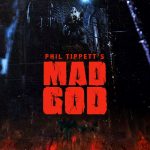Only Lovers Left Alive (2013)

Only Lovers Left Alive, directed by Jim Jarmusch and released in 2013, is a unique take on the vampire genre, blending romance, dark humor, and philosophical musings. The film is a slow-burning, atmospheric story about two ancient vampires, Adam (Tom Hiddleston) and Eve (Tilda Swinton), who navigate love, art, and existential malaise in a modern world that feels increasingly alien to them. It’s a film that uses vampirism as a lens through which to explore themes of isolation, immortality, and the clash between old and new.
Suggested videos for you:
Plot Overview
The story centers on Adam and Eve, who have been lovers for centuries. Adam, a reclusive musician living in a decaying house in Detroit, has grown weary of humanity, whom he derisively calls “zombies.” He’s disillusioned by the degradation of culture, technology, and the environment, and contemplates suicide out of existential despair. Eve, on the other hand, resides in Tangier, Morocco, and embraces life with a quiet wisdom, finding solace in literature, nature, and her connection to the past.
When Eve senses Adam’s despair, she travels to Detroit to comfort him, and they spend their nights discussing art, music, and philosophy while quietly reflecting on their place in a world that feels increasingly alien. Their relatively peaceful existence is disrupted by the arrival of Eve’s wild, reckless sister, Ava (Mia Wasikowska), whose behavior brings unforeseen complications.
Unlike most vampire films, Only Lovers Left Alive is not driven by plot twists or action sequences. Instead, it is an introspective journey, focusing on the internal lives of its characters and their shared struggle to find meaning in a world that seems to have lost its soul.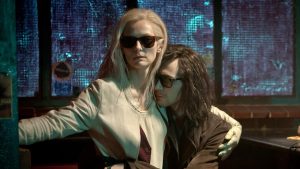
Themes and Philosophical Musings
The film’s core themes revolve around immortality, cultural decay, and the weight of memory. Adam and Eve are portrayed as cultural preservationists, bearing witness to the decline of art and intellectualism over centuries. Through their conversations, Jarmusch explores the cyclical nature of human creativity and destruction, and Adam’s despair reflects a deep nostalgia for a bygone era of artistic greatness, where figures like Shakespeare and Nikola Tesla were celebrated.
Their vampirism symbolizes both an unbreakable connection to the past and an inherent distance from humanity. Adam, in particular, is a romantic figure, filled with disdain for the modern world and its superficiality. He is tormented by the trivialization of art and the environmental destruction caused by humans. Eve, by contrast, is more resilient and adaptable, finding beauty in small moments and seeing life as something to be cherished despite its imperfections.
The concept of love, particularly a love that endures for centuries, is another central theme. Adam and Eve’s relationship is characterized by deep respect, understanding, and a mutual appreciation of each other’s quirks and flaws. They are soulmates in the truest sense, bonded by shared experiences and a connection that transcends the physical. Their love is portrayed as both an anchor and a burden; it gives them purpose but also keeps them bound to an endless existence that, at times, feels like a curse.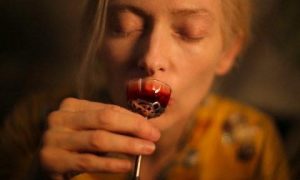
Visual Style and Cinematography
Only Lovers Left Alive is a visually arresting film, with cinematography by Yorick Le Saux that captures both the decaying beauty of Detroit and the vibrant, ancient allure of Tangier. Jarmusch and Le Saux use lighting and color to emphasize the stark contrast between these two settings. Detroit, with its crumbling buildings and abandoned streets, reflects Adam’s sense of decay and desolation. The city is often bathed in dark, muted tones, highlighting its ghostly, post-industrial landscape.
In contrast, Tangier is warm, with rich oranges and deep shadows, evoking a sense of timelessness and exotic beauty. This visual duality underscores the characters’ emotional states: Adam is entrenched in melancholy, surrounded by decay, while Eve, in Tangier, lives in an environment filled with life and history. The visual style enhances the film’s meditative tone, creating a sense of atmosphere that draws viewers into the world of these timeless characters.
The film’s attention to detail is remarkable, with carefully curated props and costumes that reflect the characters’ long histories. Adam’s home is filled with analog recording equipment, vintage guitars, and old books, signaling his disdain for modern technology and his desire to remain anchored in the past. Eve, by contrast, wears flowing, light-colored clothes that echo her fluid, adaptable nature. The set design and costuming contribute to the film’s overall aesthetic, giving it a dreamlike quality that is both haunting and beautiful.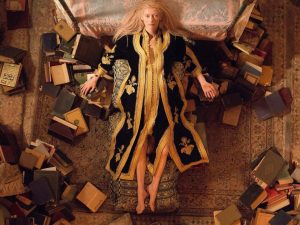
Soundtrack and Sound Design
Music plays a pivotal role in Only Lovers Left Alive. The soundtrack, composed by Jozef van Wissem and Jarmusch’s own band, SQÜRL, is a hypnotic blend of distorted guitars, reverb-heavy sounds, and haunting melodies that perfectly complement the film’s nocturnal, introspective vibe. The music reflects Adam’s brooding nature and his obsession with preserving the past, with tracks that evoke a sense of timelessness and otherworldly beauty.
In addition to the original score, the film incorporates pieces by various artists, including Middle Eastern music that underscores Eve’s scenes in Tangier. The soundtrack acts as a kind of emotional undercurrent, enhancing the film’s atmosphere and highlighting the characters’ shared love for art and music. For Adam, music is a form of expression that has kept him connected to his humanity, even as he grows increasingly detached from the world around him.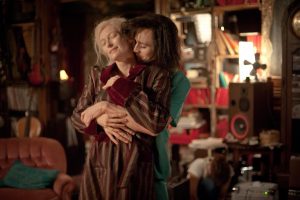
Character Performances
The performances by Tilda Swinton and Tom Hiddleston are central to the film’s success. Swinton, with her ethereal presence and otherworldly calm, perfectly embodies Eve’s ancient wisdom and resilience. She brings a gentle warmth to the role, making Eve both relatable and mysterious. Hiddleston, on










